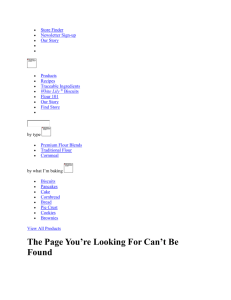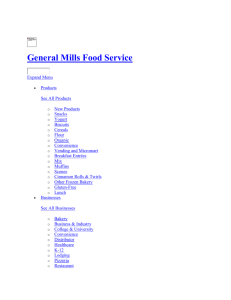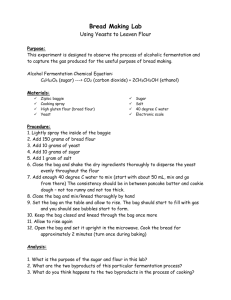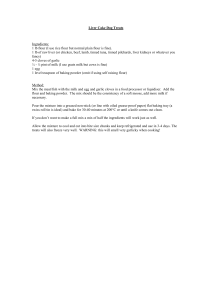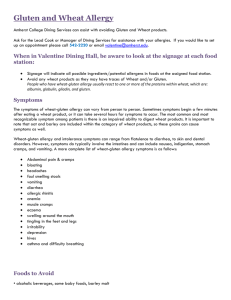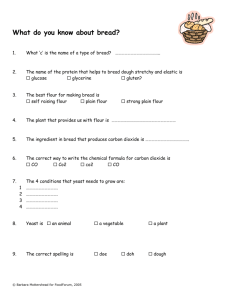Guidance Notes - Food Standards Agency
advertisement
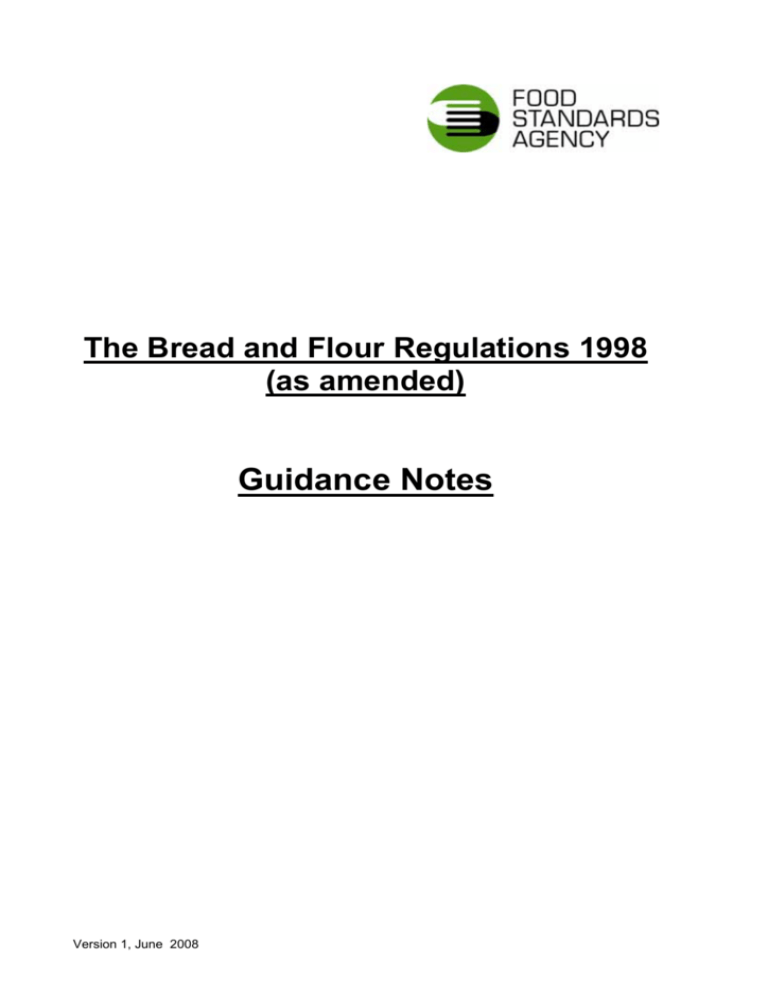
The Bread and Flour Regulations 1998 (as amended) Guidance Notes Version 1, June 2008 Important Note This Guidance has been produced with the aim of providing informal, non-statutory advice and should be read in conjunction with the appropriate legislation. The text should not be taken as an authoritative statement or interpretation of the law, as only the courts have this power. Every effort has been made to ensure that these guidance notes are as helpful as possible. However, it is ultimately the responsibility of individual businesses to ensure their compliance with the law. Businesses with specific queries may wish to seek the advice of their local enforcement agency, which will usually be the Local Authority Trading Standards Department. In the Devolved Administrations that may be the Environmental Health Department. 1 Introduction 3 The relevant legislation Purpose of the legislation 3 3 2 Scope of the Bread and Flour Regulations 1998 4 3 4 Products covered by the Regulations Exemptions Compositional Requirements for flour Use of the words “wholemeal” and “wheat germ” Additives Presentation of labelling information Enforcement Issues Further information 4 4 5 5 6 6 8 8 Annex 1 Required additional ingredients in flour 10 2 1. Introduction The relevant legislation These Guidance notes relate to the provisions of the following legislation: • • • • The Bread and Flour Regulations 1998 (SI 1998/141 as amended) 1 Regulation 18(1)(e) of The Food Labelling Regulations 1996 (FLRs) (SI 1996/1499 as amended) 2 The Miscellaneous Food Additives (Amendment) Regulations 1999 (SI 1995/3187 as amended) 3 Regulation (EC) No 1924/2006 on nutrition and health claims made on foods In addition, all products covered by the Regulations must also comply with: • • • Food Safety Act 1990 – the general provisions under which all food legislation in Great Britain is made 4 General Food Law Regulation (EC) 178/2002 - the Regulation which establishes the common basis for food law in Member States and covers all stages of the food production chain and Food Labelling Regulations 1996 – the general rules governing the labelling of foods Other horizontal legislation such as food additives legislation, also applies to products covered by the Bread and Flour Regulations. Agency guidance notes on specific pieces of legislation are available on the Agency’s website at: http://www.food.gov.uk/foodindustry/guidancenotes/ Purpose of the legislation The Bread and Flour Regulations 1998 revoked and replaced the Bread and Flour Regulations 1995. The Regulations are national rules and apply to Scotland, Wales, Northern Ireland (which has separate but equivalent rules - see footnotes) and England. The Regulations have been notified under the technical standards Directive to the European Commission. The Directive, by providing specific information procedures, aims to eliminate or reduce the barriers to free movements of goods which can arise from the adoption of different national technical regulations and encourages transparency. 1 In Northern Ireland, the equivalent legislation is Bread and Flour Regulations (Northern Ireland) 1998 (SR 1998/24) Food Labelling Regulations (Northern Ireland) 1996 (as amended) (SR 1996/383 3 In Northern Ireland, the equivalent legislation is Miscellaneous Food Additives (Amendment) Regulations (Northern Ireland) 1999 (as amended) (S.R. 1999/244). 2 4 In Northern Ireland, the equivalent legislation is the Food Safety (Northern Ireland) Order 1991. 3 The Bread and Flour Regulations 1998 lay down labelling and compositional standards for the breads and flours to which they apply. They also continue with a long standing national requirement to restore certain vitamins and minerals to flour manufactured and sold in the UK. 2. Scope of the Bread and Flour Regulations 1998 Products covered by the Regulations Regulation 2 The Regulations apply to bread and flour that are intended for human consumption. Flour The Regulations apply to flour which is derived from the milling or grinding of cleaned cereal. The term cereal, which is not defined in the Regulations, would generally indicate foods that are produced using edible grass grains such as wheat, barley, oats, rye and corn 5 . However, the compositional requirements (see section on regulation 4 below) apply to flour made from wheat only. Bread The Regulations apply to “bread” defined “as a food of any size, shape or form which is usually known as bread and consists of a dough, made from flour and water with or without other ingredients, which has been fermented by yeast or otherwise leavened and subsequently baked or partly baked”. The Regulations do not apply to: • buns, • bun loaves, • chapatis, • chollas, • pitta bread, • potato bread or • bread specially prepared for coeliac sufferers (i.e. people allergic to the gluten found in wheat products). Exemptions Regulation 3 In line with the European single market the national rules on bread and flour contained in this Regulation do not apply to foods imported into the UK from other EU Member States and EEA States where they were lawfully produced and sold. Equally the requirements would not apply to bread and flour lawfully produced outside the EU and brought into the UK from a Member State (or EEA state) in which it was in free circulation and lawfully sold. 5 “Cornflour” is generally the term used for maize starch and therefore it is outside the scope of the Regulations because it is not flour. True maize flour would be within the scope of the Regulations. 4 However, where bread or flour is directly imported from third countries (i.e. countries that are neither a Member State of the EU nor a State that has entered an association agreement with the EU Community), then the products will be required to conform to the provisions of the Regulations. Compositional Requirements for flour Regulation 4 and Schedule 1 The Regulations require that, subject to certain exceptions, four specific nutrients in specified quantities must be added to all wheat flour, whether or not mixed with other flour. They are: • • • • Iron Thiamin (Vitamin B1), Nicotinic acid or nicotinamide and Calcium carbonate The process of milling the wheat normally causes a loss of iron, thiamin and nicotinic acid and the purpose of this requirement is to restore these vitamins and minerals to their original levels. Calcium is added for fortification purposes. The Regulations also lay down specifications regarding the chemical composition that these added vitamins and minerals must meet. The quantities and requirements are set out in Schedule 1 of the Regulations (see annex to these guidance notes). Exceptions 1. Calcium carbonate is not required to be added to: • self-raising flour which has a calcium content of not less than 0.2% • wholemeal flour • wheat malt flour. 2. Iron, thiamin (vitamin B1) and nicotinic acid or nicotinamide are not required to be added to • wholemeal flour. In the case of wholemeal flour, the regulations require that the levels of these vitamins and minerals shall be naturally present in the quantities prescribed for flour and not added. This will be because the bran and germ which is added back in wholemeal flour already contains these nutrients so additional fortification is not required. 5 Use of the words “wholemeal” and “wheat germ” Regulation 6 Regulation 6 restricts the use of the words “wholemeal” and “wheat germ”. The terms may only be used on the labelling or advertising of bread if the bread meets the following criteria: • Wholemeal - all the flour used as an ingredient in the preparation of the bread must be wholemeal. The term “wholemeal” is not defined in law, however it is generally accepted that wholemeal flour is the entire wheat grain, which contains the bran and the germ. • Wheat germ – the bread must have an added processed wheat germ content of at least 10% calculated on the dry matter of the bread. Other descriptions of bread, such as “white”, “brown”, “stone-ground” are not specifically prescribed by law. However, the use of such descriptions will be subject to the rules of the Food Labelling Regulations 1996 – “where there is no name prescribed by law for a food, the name used must be sufficiently precise to inform the purchaser of the true nature of the food and must not mislead”. Additives Regulation 5 Following the harmonisation of controls on additives, the Miscellaneous Food Additives Regulations 1995 (as amended) repealed the provisions of regulation 5 (1) and (2) and Schedule 3 of the Bread and Flour Regulations 1998 relating to additives. This means that the Bread and Flour Regulations no longer have their own requirements on flour treatment agents. Treatment agents are now subject to the general requirements contained in the Miscellaneous Food Additives Regulations 1995. The Miscellaneous Food Additives Regulations should be consulted to determine which additives can be used. Note that as part of these legislative changes, the use of the flour bleaching agents, e.g. chlorine and chlorine dioxide is no longer allowed. Therefore claims for the use of unbleached flour are meaningless and should be avoided. In compliance with the Miscellaneous Food Additives Regulations the use of flour treatment agents must be indicated in the ingredients list or on a ticket or on a notice for non pre-packed products including products pre-packed for direct sale. Presentation of labelling information Regulation 5 and 18(1) (e) FLRs 6 General labelling requirements for bread and flour (as required by the Food Labelling Regulations 1996 (as amended)) Bread and flour are subject to the general labelling rules of the Food Labelling Regulations 1996 (as amended). Bread and flour packaging will include details of: • • • • • • • legal name (e.g. “white bread”/”white flour” and any additional terms that may be necessary to make up an adequate legal name) ingredients list (bearing in mind the need to refer clearly to any ingredients which are subject to allergen labelling). Flour will be exempt from this requirement by virtue of regulation 18(e) “best before end ” date for flour any special storage condition or condition of use name and address of manufacturer, packer or seller particulars of place of origin if failure to give it would likely to mislead consumers loaf and flour weight. (Prescribed quantities for both bread and flour will be abolished by April 2009. For further guidance please contact the Department for Business, Enterprise and Regulatory Reform at www.berr.gov.uk) Agency Guidance Notes on the provisions of the Food Labelling Regulations are available from the Agency’s website at: http://www.food.gov.uk/foodindustry/guidancenotes/. Spelt Wheat Labelling The current allergen legislation – Food Labelling (Amendment) (No. 2) Regulation 2004 (which sets out the statutory requirements for allergen labelling and which implements Directive 2003/89/EC) – lists “spelt” as a cereal containing gluten and therefore a product containing spelt cannot be labelled as being gluten free. It may also be misleading to label a product containing “spelt” as wheat free as spelt is a type of wheat (Triticum spelta) and this would make spelt unsuitable for anyone with a wheat allergy or intolerance. Additives and Nutrients If any of the additives permitted under the Miscellaneous Food Additives Regulations are used in flour or bread, these must be listed, either by name or E number in the ingredients list. Non pre-packed bread must list on a ticket or in a notice the following categories of additives: antioxidants, colours, flavourings, flavour enhancers, preservatives and sweeteners, as opposed to all E numbers/names. However, there is currently no requirement to label the added nutrients, i.e. iron, thiamin (vitamin B1), nicotinic acid or nicotinamide and calcium carbonate. This is because of a specific exemption provided for by the Food Labelling Regulations (regulation 18 (1) (e)). 7 Nutrition Information and Claims Under the Food Labelling Regulations 1996 nutrition labelling is optional. Nutrition labelling only becomes compulsory when a nutrition claim is made. If a nutrition or health claim is made (e.g. energy or dietary fibre details), it must be in accordance with the European Council Regulation No. 1924/2006 on nutrition and health claims made on foods. This Regulation controls the use of nutrition and health claims in the advertising, labelling and presentation of all foods. Guidance on claims is available from http://www.food.gov.uk/foodindustry/guidancenotes/labelregsguidance/nutclaimsadgu id 3. Enforcement issues Responsibility for enforcement Regulation 7 Local Authorities are responsible for the enforcement of the Bread and Flour Regulations 1998 and all other Regulations mentioned in these notes. Businesses with specific queries may wish to seek the advice of their local enforcement authority, or their home authority where appropriate. Contact details for Local Authorities are available from the Agency’s website at http://www.food.gov.uk/enforcement/laresource/yourarea/. 4. Further information For further information on the legislation and policy relating to bread and flour, please contact: Labelling, Standards and Allergy Division – Room 115 B (6th Floor after October 2008) Food Standards Agency Aviation House 125 Kingsway London WC2B 6NH Telephone: 020 7276 8154 Fax: 020 7276 8193 e-mail: Michelle.McQuillan@foodstandards.gsi.gov.uk or Donatella.Howe@foodstandards.gsi.gov.uk or Richard.Wood@foodstandards.gsi.gov.uk For further information and Guidance Notes relating to the provisions of the Food Labelling Regulations, please write to the address above, or contact: labelling@foodstandards.gsi.gov.uk or tel. 020 7276 8147 8 For further information on the legislation in the devolved administrations, please contact: In Wales: Food Standards Agency Wales 1st Floor, Southgate House Wood Street Cardiff CF10 1EW Telephone: 029 2067 8911 E-mail: wales@foodstandards.gsi.gov.uk In Scotland: Food Standards Agency Scotland 6th Floor St Magnus House 25 Guild Street Aberdeen AB11 6NG Telephone: 01224 285155 In Northern Ireland: Food Standards Agency Northern Ireland 10A-C Clarendon Road Belfast BT1 3BG Telephone: 028 9041 7700 E-mail: mervyn.briggs@foodstandards.gsi.gov.uk. 9 Annex 1 Required additional ingredients in flour Required quantity, in milligrams per hundred grams of flour, and conditions of use Calcium Carbonate not less than 235, and not more than 390, Iron conforming to the following Description: Fine white microcrystalline or amorphous powder Content: Not less than 97 per cent of CaCO3 on a volatile matter-free basis Volatile matter: Not more than 1 per cent (determined by drying at 105°C to constant weight) Matter insoluble in hydrochloric acid: Shall comply with the requirement for aluminium, iron, phosphate and matter insoluble in hydrochloric acid in the monograph for chalk in the British Pharmacopoeia 1973 at page 93 Arsenic: Not more than 5 mg per kg Lead: Not more than 20 mg per kg Other inorganic impurities: Not more than 100 mg per kg of any of the following substances, namely antimony, copper, chromium, zinc or barium sulphate, or more than 200 mg per kg of any combination of those substances Particle size: Not more than 0.1 per cent to remain on a sieve of nominal aperture size 150 µm and not more than 0.2 per cent to remain on a sieve of nominal aperture size 63 µm. not less than 1.65 in the form of any, or any combination of two or more, of the following ferric ammonium citrate conforming to the criteria in the monograph for ferric ammonium citrate contained in the British Pharmacopoeia 1973 at page 201; (ii) green ferric ammonium citrate conforming to the criteria for ammonium ferric citrate contained in the British Pharmaceutical Codex 1973 at page 194; (iii) ferrous sulphate conforming to the criteria in the monograph for ferrous sulphate contained in the British Pharmacopoeia 1988 at page 245; (iv) dried ferrous sulphate conforming to the criteria in the monograph for dried ferrous sulphate contained in the British Pharmacopoeia 1988 at page 245; Thiamin Nicotinic Acid or Nicotinamide (v) iron powder conforming to the description, specification and requirements contained in Schedule 2 of the regulations. not less than 0.24 in a form conforming to the criteria in the monograph for thiamin hydrochloride contained in the British Pharmacopoeia 1980 at page 451. not less than 1.60 in a form conforming to the criteria in the monograph for nicotinic acid contained in the British Pharmacopoeia 1973 at page 318 not less than 1.60 in a form conforming to the criteria in the monograph for nicotinamide contained in the British Pharmacopoeia 1980 at page 303. 10
